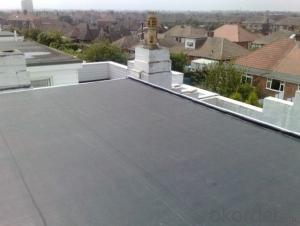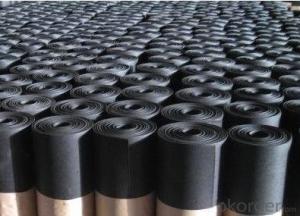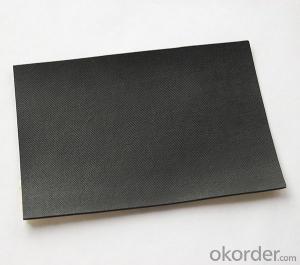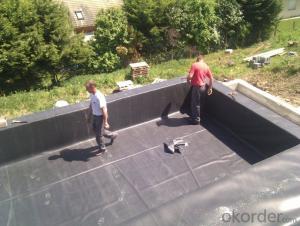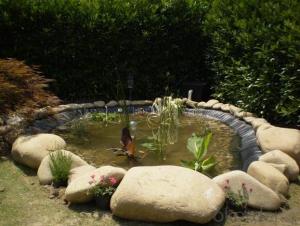EPDM Coiled Rubber Waterproof Membrane with Recycled Material
- Loading Port:
- Shanghai
- Payment Terms:
- TT OR LC
- Min Order Qty:
- 50000 m²
- Supply Capability:
- 5000000 m²/month
OKorder Service Pledge
OKorder Financial Service
You Might Also Like
EPDM Coiled Rubber Waterproof Membrane with Recycled Material
Description Of EPDM Coiled Rubber Waterproof Membrane with Recycled Material:
•EPDM waterproof sheet has excellent anti-ozone-aging performance, able to resist ultraviolet light and corrosion of many chemical corrosive materials in the atmosphere
•It has high tensile strength, high ductility and strong retractility, it has excellent crack resistance, able to effect waterproof function even with tiny vibration of buildings.
• Excellent resistance to ozone, oxidation and sunlight.
• Resistance to chemicals; resistant to most inorganic products.
Main Features of EPDM Coiled Rubber Waterproof Membrane with Recycled Material:
A.Polyester based SBS Modified Bitumen Waterproofing Membrane
a. Strong impermeability
b. High tensile strength, elongation, ability to adapt the grassroots shrinkage deformation and cracking
c. Puncture-resistant, broken resistant, tear-resistant
d. The corrosion resistance, resistance to mildew, weathering good
e. Construction convenient, hot-melt can be operated Four Seasons Construction, reliable joints
Specifications of EPDM Coiled Rubber Waterproof Membrane with Recycled Material:
| Material | EPDM Rubber |
| Size | 1.2m (width)*20m (length) or customized, weldable type 2.05m or 4m width |
| Thick | 1.2mm, 1.5mm, 2.0mm |
| Type | Vulcanized & Weldable |
| Pattern | Non-reinforced (homogeneous) |
| Certificate | ISO9001/14001 |
Applications of EPDM Coiled Rubber Waterproof Membrane with Recycled Material:
1. The substratum should be smooth, dry, clean, which can not have loosing and peeling phenomena.
2. Before application, clean up the basic level and eradicate the impurities.
3. Spread out the membrane on the substratum to loose sheet's stress. Use adhesive-glue to paint the substratum and the surface of membrane. When the adhesive is not sticky to hands, pave and press smoothly.
4. When pave the second volume of membrane, extrude 100mm of the edge of overlap of the first roll and do not paint with the adhesive. Pave the membrane on the substratum according to step so as to finish the whole pavement. When paving, do not tighten the waterproof membrane violently.
5. After that, use the special solvent to scrub the overlap joint. When it becomes fully dry , use the sheet glue to paint the both sides of the joint. Paint it again when it gets completely dry. Till the adhesive is not sticky to hands, press it smoothly and solidly.
6. Pay attention to fire prevention during application. Basement construction site shall be equipped with ventilation facilities



IMages of EPDM Coiled Rubber Waterproof Membrane with Recycled Material:




FAQ of EPDM Coiled Rubber Waterproof Membrane with Recycled Material:
1. What are we supplying?
We are specialized in producing Colorful Asphalt Roof Shingle, SBS/APP modified bitumen waterproof membrane, Self adhesive bitumen waterproof membrane, PVC waterproofing membrane, EPDM rubber roofing membrane, Single Component Polyurethane Waterproof Coating, and Spray Polyurea Waterproof Coating
.
2. How Many years experience do we have?
We have been exported to more than 20 countries in the past 15 years.
3. How long do we usually reply your request?
We always reply our customer within 24 hours.
- Q:Can a waterproofing membrane be used on roofs with rooftop gardens?
- Yes, a waterproofing membrane can be used on roofs with rooftop gardens. In fact, it is highly recommended to use a waterproofing membrane to protect the underlying structure from water damage. A rooftop garden adds additional weight and moisture to the roof, so a proper waterproofing system is essential to prevent leaks and ensure the longevity of the roof. The waterproofing membrane acts as a barrier against water infiltration and helps to keep the rooftop garden and the building below dry.
- Q:Can a waterproofing membrane be applied over existing coatings?
- Yes, a waterproofing membrane can be applied over existing coatings. However, it is important to ensure that the existing coating is in good condition and properly adhered to the surface. Any loose or damaged areas should be repaired before applying the waterproofing membrane to ensure its effectiveness.
- Q:Can a waterproofing membrane be applied in cold weather conditions?
- Applying a waterproofing membrane in cold weather is possible, but the temperature range may differ depending on the product and manufacturer guidelines. Certain membranes can endure cold temperatures and be applied as low as -20 degrees Celsius (-4 degrees Fahrenheit), while others may have a higher minimum application temperature. Following the manufacturer's instructions is crucial, as well as ensuring the surface is adequately prepared and free from ice, snow, or moisture. Consulting with an experienced professional contractor who has worked with waterproofing membranes in cold weather conditions is also recommended for optimal results.
- Q:Can a waterproofing membrane be used for a planter roof?
- Yes, a waterproofing membrane can be used for a planter roof. Waterproofing membranes are designed to provide a protective barrier against water penetration, making them suitable for preventing water damage to the roof and underlying structures, including planter boxes.
- Q:BS waterproofing membrane is modified? There are not a few thick drawings, how to do
- Do not indicate the thickness can contact the design unit, you can also judge according to the waterproof level
- Q:What is the typical installation process for a waterproofing membrane?
- Installing a waterproofing membrane typically involves several steps. Firstly, the surface requiring waterproofing is thoroughly cleaned and prepared by eliminating any existing coatings, debris, or loose materials. It is essential to guarantee that the surface is smooth, clean, and devoid of any contaminants that may hinder the membrane's adhesion. Secondly, any cracks, holes, or imperfections in the surface are repaired. This entails filling cracks with a suitable filler or patching compound and smoothing out rough areas. It is crucial to have a solid and even surface to ensure proper installation and efficacy of the waterproofing membrane. Once the surface is prepared, it is often necessary to apply a primer to enhance adhesion between the surface and the membrane. The primer is typically applied using a brush or roller, following the manufacturer's instructions. After the primer has dried, the waterproofing membrane is mounted. There are various types of membranes available, such as sheet membranes or liquid-applied membranes. Sheet membranes are usually rolled out onto the surface and adhered using an appropriate adhesive or mortar. Liquid-applied membranes are applied using a brush, roller, or spray equipment to create a continuous and seamless barrier. Throughout the installation process, it is crucial to ensure correct membrane installation with proper overlap or seams. Additionally, any penetrations or transitions must be adequately treated and sealed. This includes areas such as corners, edges, drains, and pipe penetrations, where additional detailing may be necessary to create a watertight seal. Once the membrane is installed, it is important to allow it to cure or dry according to the manufacturer's instructions. This ensures that the membrane reaches its maximum strength and waterproofing capabilities. Finally, after the membrane has cured, it may be beneficial to apply a protective layer or coating to enhance the durability and longevity of the waterproofing system. This may involve applying a topcoat, sealant, or protective barrier to shield the membrane from UV rays, foot traffic, or other potential sources of damage. In summary, the installation process for a waterproofing membrane includes surface preparation, primer application, membrane installation, detailing and sealing, curing, and potentially applying a protective layer. It is crucial to adhere to the manufacturer's instructions and consult with a professional if necessary to ensure proper and effective installation.
- Q:Can a waterproofing membrane be used for bridge abutments?
- Bridge abutments can be safeguarded using a waterproofing membrane. These membranes are commonly utilized in the construction industry to safeguard structures from moisture damage and prevent water infiltration. Due to their close proximity to water bodies and potential exposure to groundwater, bridge abutments are particularly at risk of water damage. The application of a waterproofing membrane on bridge abutments serves as a protective barrier against water penetration, effectively shielding the structure from potential harm. To ensure comprehensive protection, the membrane is typically installed on the abutment walls and extends below ground level. Waterproofing membranes are designed to be both durable and flexible, enabling them to withstand movement and settling that may occur in bridge abutments. Materials such as bitumen, PVC, or modified bitumen are commonly used to create these membranes, as they offer exceptional resistance to water and other environmental factors. By incorporating a waterproofing membrane on bridge abutments, engineers and contractors can guarantee the structure's longevity and safety. It effectively mitigates moisture-related issues, including concrete deterioration, corrosion of reinforcing steel, and the emergence of cracks and leaks. Furthermore, the membrane can serve as a vapor barrier, reducing the likelihood of condensation and moisture buildup within the abutments. In conclusion, waterproofing membranes provide an effective solution for safeguarding bridge abutments against water damage. They establish a dependable barrier against water penetration, ensuring the structural integrity and longevity of the bridge.
- Q:Can waterproofing membranes be used on concrete block walls?
- Yes, waterproofing membranes can be used on concrete block walls. In fact, it is often recommended to use waterproofing membranes on concrete block walls to prevent water infiltration and moisture damage. Waterproofing membranes are designed to create a barrier against water and can be applied to the exterior or interior surface of the concrete block walls. These membranes provide an additional layer of protection, preventing moisture from seeping into the walls and causing issues such as mold growth, efflorescence, and deterioration of the concrete blocks. By using waterproofing membranes, you can ensure the longevity and durability of your concrete block walls.
- Q:Can a waterproofing membrane be used on tunnels with ventilation systems?
- Yes, a waterproofing membrane can be used on tunnels with ventilation systems. In fact, it is commonly used to prevent water infiltration and protect the structure of the tunnel. The membrane is installed on the exterior walls and ceiling of the tunnel, ensuring that any water that may enter is diverted away from the tunnel and its ventilation system. This helps to maintain the integrity of the tunnel and ensures proper functioning of the ventilation system.
- Q:Are waterproofing membranes suitable for rooftop gardens?
- Yes, waterproofing membranes are suitable for rooftop gardens. As rooftop gardens are located on top of buildings, it is essential to have proper waterproofing in place to prevent water leakage and damage to the structure. Waterproofing membranes are specially designed to create a barrier that prevents water from seeping into the building. These membranes are typically made of materials such as rubber, PVC, or modified bitumen, which are highly resistant to water penetration. Rooftop gardens involve the use of soil and plants, which require regular watering. Without a reliable waterproofing system, excess water from irrigation or rainfall can seep into the building, leading to issues like water damage, mold growth, and structural deterioration. Waterproofing membranes provide a durable and long-lasting solution to this problem by effectively sealing the rooftop and preventing any water infiltration. Moreover, waterproofing membranes can also offer additional benefits for rooftop gardens. They act as a protective layer against root penetration, preventing plant roots from damaging the roof structure. Additionally, these membranes can help to regulate the temperature of the building by reducing heat absorption from the sun, thereby improving energy efficiency. It is important to note that the selection and installation of waterproofing membranes should be done by professionals with expertise in waterproofing systems. They will ensure that the membranes are correctly installed, free from any defects or punctures, and properly integrated with other roofing components. In conclusion, waterproofing membranes are indeed suitable for rooftop gardens as they provide the necessary protection against water ingress, root penetration, and structural damage. By investing in a reliable waterproofing system, rooftop gardens can thrive while maintaining the integrity and longevity of the building beneath.
1. Manufacturer Overview |
|
|---|---|
| Location | |
| Year Established | |
| Annual Output Value | |
| Main Markets | |
| Company Certifications | |
2. Manufacturer Certificates |
|
|---|---|
| a) Certification Name | |
| Range | |
| Reference | |
| Validity Period | |
3. Manufacturer Capability |
|
|---|---|
| a)Trade Capacity | |
| Nearest Port | |
| Export Percentage | |
| No.of Employees in Trade Department | |
| Language Spoken: | |
| b)Factory Information | |
| Factory Size: | |
| No. of Production Lines | |
| Contract Manufacturing | |
| Product Price Range | |
Send your message to us
EPDM Coiled Rubber Waterproof Membrane with Recycled Material
- Loading Port:
- Shanghai
- Payment Terms:
- TT OR LC
- Min Order Qty:
- 50000 m²
- Supply Capability:
- 5000000 m²/month
OKorder Service Pledge
OKorder Financial Service
Similar products
New products
Hot products
Related keywords
